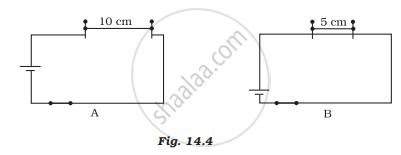Advertisements
Advertisements
प्रश्न
Three heaters each rated 250 W, 100 V are connected in parallel to a 100 V supply. Calculate:
- the total current taken from the supply
- the resistance of each heater and
- the energy supplied in kWh to the three heaters in 5 hours.
उत्तर
Given,
Power, p = 250 w
Voltage, v = 100 v
- Current through each heater, I = ?
As p = VI
I = `"P"/"V"`
= `250/100`
= 2.5 A
∴ Current taken for the three heaters = 3 × 2.5
= 7.5 A - resistance for each heater, R = `"V"/"I"`
= `100/2.5`
= 40 Ω - Time for which energy is supplied, t = 5h
As, Energy, E = p × t
For each heater E = 250 × 5
= 1250 wh or E = 1.25 kwh
Energy for three heaters = 3 × 1.25
= 3.75 kwh
संबंधित प्रश्न
How much heat will an instrument of 12 W produce in one minute if it is connected to the heat produced by it?
The elements of electrical heating devices are usually made of:
(a) tungsten
(b) bronze
(c) nichrome
(d) argon
Give Scientific reason.
In practice, the unit kWh is used for the measurement of electrical energy, rather than joule.
Name the factors on which the heat produced in a wire depends when current is passed in it, and state how does it depend on the factors stated by you.
Write two devices based on the heating effect of electric current.
When does overloading occur?
Three incandescent bulbs of 100 W each are connected in series in an electric circuit. In another circuit another set of three bulbs of the same wattage are connected in parallel to the same source.
- Will the bulb in the two circuits glow with the same brightness? Justify your answer.
- Now let one bulb in both the circuits get fused. Will the rest of the bulbs continue to glow in each circuit? Give reason.
Paheli took a wire of length of 10 cm. Boojho took a wire of 5 cm of the same material and thickness. Both of them connected the wires as shown in the circuit given in Figure 14.4. The current flowing in both circuits is the same.
(i) Will the heat produced in both cases be equal? Explain
(ii) Will the heat produced be the same if the wires taken by them are of equal lengths but of different thicknesses? Explain.

Match the following
| 1. | Bulb | a. | Conductor |
| 2. | Electroplating | b. |
Insulator |
| 3. | Pure water | c. | Heating effect of current |
| 4. | Salt solution | d. | Chemical effect of current |
Two students decided to investigate the effect of water and air on iron object under identical experimental conditions. They measured the mass of each object before placing it partially immersed in 10 ml of water. After a few days, the object were removed, dried and their masses were measured. The table shows their results.
| Student | Object | Mass of Object before Rusting in g |
Mass of the coated object in g |
| A | Nail | 3.0 | 3.15 |
| B | Thin plate | 6.0 | 6.33 |
What might be the reason for the varied observations of the two students?
